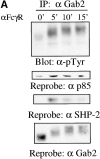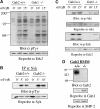Critical role for scaffolding adapter Gab2 in Fc gamma R-mediated phagocytosis
- PMID: 12821647
- PMCID: PMC2172986
- DOI: 10.1083/jcb.200212158
Critical role for scaffolding adapter Gab2 in Fc gamma R-mediated phagocytosis
Abstract
Grb2-associated binder 2 (Gab2), a member of the Dos/Gab subfamily scaffolding molecules, plays important roles in regulating the growth, differentiation, and function of many hematopoietic cell types. In this paper, we reveal a novel function of Gab2 in Fcgamma receptor (FcgammaR)-initiated phagocytosis in macrophages. Upon FcgammaR activation, Gab2 becomes tyrosyl phosphorylated and associated with p85, the regulatory subunit of phosphoinositide 3-kinase (PI3K), and the protein-tyrosine phosphatidylinositol Shp-2. FcgammaR-mediated phagocytosis is severely impaired in bone marrow-derived macrophages from Gab2-/- mice. The defect in phagocytosis correlates with decreased FcgammaR-evoked activation of Akt, a downstream target of PI3K. Using confocal fluorescence microscopy, we find that Gab2 is recruited to the nascent phagosome, where de novo PI3K lipid production occurs. Gab2 recruitment requires the pleckstrin homology domain of Gab2 and is sensitive to treatment with the PI3K inhibitor wortmannin. The Grb2 binding site on Gab2 also plays an auxiliary role in recruitment to the phagosome. Because PI3K activity is required for FcgammaR-mediated phagocytosis, our results indicate that Gab2 acts as a key component of FcgammaR-mediated phagocytosis, most likely by amplifying PI3K signaling in the nascent phagosome.
Figures
















Similar articles
-
Scaffolding adapter Grb2-associated binder 2 requires Syk to transmit signals from FcepsilonRI.J Immunol. 2006 Feb 15;176(4):2421-9. doi: 10.4049/jimmunol.176.4.2421. J Immunol. 2006. PMID: 16456001
-
Activated STAT5 proteins induce activation of the PI 3-kinase/Akt and Ras/MAPK pathways via the Gab2 scaffolding adapter.Biochem J. 2005 Aug 15;390(Pt 1):359-66. doi: 10.1042/BJ20041523. Biochem J. 2005. PMID: 15833084 Free PMC article.
-
The absence of Grb2-associated binder 2 (Gab2) does not disrupt NK cell development and functions.J Leukoc Biol. 2004 Oct;76(4):896-903. doi: 10.1189/jlb.0304179. Epub 2004 Jul 7. J Leukoc Biol. 2004. PMID: 15240750
-
Structure and function of Gab2 and its role in cancer (Review).Mol Med Rep. 2015 Sep;12(3):4007-4014. doi: 10.3892/mmr.2015.3951. Epub 2015 Jun 17. Mol Med Rep. 2015. PMID: 26095858 Free PMC article. Review.
-
Gab-family adapter molecules in signal transduction of cytokine and growth factor receptors, and T and B cell antigen receptors.Leuk Lymphoma. 2000 Apr;37(3-4):299-307. doi: 10.3109/10428190009089430. Leuk Lymphoma. 2000. PMID: 10752981 Review.
Cited by
-
Regulation of in vitro and in vivo immune functions by the cytosolic adaptor protein SKAP-HOM.Mol Cell Biol. 2005 Sep;25(18):8052-63. doi: 10.1128/MCB.25.18.8052-8063.2005. Mol Cell Biol. 2005. PMID: 16135797 Free PMC article.
-
A novel role for Gab2 in bFGF-mediated cell survival during retinoic acid-induced neuronal differentiation.J Cell Biol. 2005 Jul 18;170(2):305-16. doi: 10.1083/jcb.200505061. Epub 2005 Jul 11. J Cell Biol. 2005. PMID: 16009726 Free PMC article.
-
Early steps of clathrin-mediated endocytosis involved in phagosomal escape of Fcgamma receptor-targeted adenovirus.J Virol. 2005 Feb;79(4):2604-13. doi: 10.1128/JVI.79.4.2604-2613.2005. J Virol. 2005. PMID: 15681460 Free PMC article.
-
DRK/DOS/SOS converge with Crk/Mbc/dCed-12 to activate Rac1 during glial engulfment of axonal debris.Proc Natl Acad Sci U S A. 2014 Aug 26;111(34):12544-9. doi: 10.1073/pnas.1403450111. Epub 2014 Aug 6. Proc Natl Acad Sci U S A. 2014. PMID: 25099352 Free PMC article.
-
Modeling of cell signaling pathways in macrophages by semantic networks.BMC Bioinformatics. 2004 Oct 19;5:156. doi: 10.1186/1471-2105-5-156. BMC Bioinformatics. 2004. PMID: 15494071 Free PMC article.
References
-
- Coppolino, M.G., R. Dierckman, J. Loijens, R.F. Collins, M. Pouladi, J. Jongstra-Bilen, A.D. Schreiber, W.S. Trimble, R. Anderson, and S. Grinstein. 2002. Inhibition of phosphatidylinositol-4-phosphate 5-kinase Iα impairs localized actin remodeling and suppresses phagocytosis. J. Biol. Chem. 277:43849–43857. - PubMed
-
- Cox, D., C.C. Tseng, G. Bjekic, and S. Greenberg. 1999. A requirement for phosphatidylinositol 3-kinase in pseudopod extension. J. Biol. Chem. 274:1240–1247. - PubMed
Publication types
MeSH terms
Substances
Grants and funding
LinkOut - more resources
Full Text Sources
Molecular Biology Databases
Research Materials
Miscellaneous

